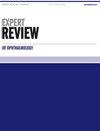鱼眼病的散光:散光的视觉质量和角度依赖性
IF 0.9
Q4 OPHTHALMOLOGY
引用次数: 0
摘要
摘要目的通过测定杂散光值来量化视觉主诉,研究杂散光的角度依赖性,并检验杂散光在鱼眼病(FED)患者临床决策中的应用。研究设计和方法采用补偿比较法(Oculus C-Quant)测量10例FED患者的Straylight。此外,对四名患者采用直接比较法测量不同视角下的杂散光。结果FED未治疗眼的平均散光为1.91 log(s)。穿透性角膜移植术和深前板层角膜移植术治疗的眼睛的平均杂散光水平分别为1.53 log(s)和1.63 log(s.)。FED中的Straylight没有强烈的角度依赖性。结论斜视高度升高(高达24倍年龄正常值),但视力相对较好。对于一些患者来说,主诉严重到可以进行角膜移植,从而减少了散光并减轻了主诉。FED中的Straylight遵循相对正常的角度依赖性。我们得出的结论是,即使视力保持正常,杂散光测量也可以通过量化视觉质量下降的投诉来支持临床决策。本文章由计算机程序翻译,如有差异,请以英文原文为准。
Straylight in fish-eye disease: visual quality and angular dependence of straylight
ABSTRACT Aim To quantify visual complaints by determining straylight values, to investigate the angular dependency of straylight, and to examine the use of straylight for clinical decision making in fish-eye disease (FED) patients. Research design and methods Straylight was measured in 10 patients with FED using the compensation comparison method (Oculus C-Quant). Additionally, the direct comparison method was used for four patients to measure straylight at different visual angles. Results Average straylight in untreated eyes with FED was 1.91 log(s). Penetrating keratoplasty and deep anterior Lamellar keratoplasty treated eyes had average straylight levels of 1.53 log(s) and 1.63 log(s), respectively. Straylight in FED was not strongly angle dependent. Conclusions Straylight was highly elevated (up to 24x age normal value) although visual acuity was relatively well preserved. For several patients, complaints were severe enough to undergo corneal transplantation resulting in reduced straylight and alleviation of complaints. Straylight in FED follows relatively normal angular dependence. We conclude that straylight measurements can support clinical decision-making by quantifying complaints about reduced visual quality, even if visual acuity remains normal.
求助全文
通过发布文献求助,成功后即可免费获取论文全文。
去求助
来源期刊

Expert Review of Ophthalmology
Health Professions-Optometry
CiteScore
1.40
自引率
0.00%
发文量
39
期刊介绍:
The worldwide problem of visual impairment is set to increase, as we are seeing increased longevity in developed countries. This will produce a crisis in vision care unless concerted action is taken. The substantial value that ophthalmic interventions confer to patients with eye diseases has led to intense research efforts in this area in recent years, with corresponding improvements in treatment, ophthalmic instrumentation and surgical techniques. As a result, the future for ophthalmology holds great promise as further exciting and innovative developments unfold.
 求助内容:
求助内容: 应助结果提醒方式:
应助结果提醒方式:


